
Itineraries
The salt pans of Kutch
Here’s a quick way in which you can tailor-make your holidays, pick the access and exit points that are most convenient, throw in a few activities and stopovers of interest, give us your budget outline, and we’ll do the rest!
Access points – from where would you like to start your journey to Kutch?
Stopovers – all the local places of interest
Bhuj sightseeing:
Bhujiyo Dungar: a 160m hill, which inspired the name Bhuj, overlooks the city and is said to be the home of the great serpent Bhujang.
Aaina Mahal: Aaina Mahal is a beautiful palace built in 1752. The name Aaina Mahal means ‘Palace of Mirrors’, and the structure has an elaborately mirrored interior which speaks of the opulence and grandeur of a bygone era. Maharao Lakhpatji, the person who commisioned the palace was fascinated by all things flamboyant and extravagant and it is evident the moment one enters the building. The architecture of the palace is heavily influenced by a European style of décor, from the blue-and-white Delphi-style tiling and the Hogarth lithograph series to Belgium chandeliers and intricately carved, gold plated mirror frames in the Rococo style. It is a wonderful experience to walk through these rooms and soak in the grandeur.
Prag Mahal: Prag Mahal, the palatial residence of Maharao Lakhpatji, was built in the 18th century under the patronage of king Pragmal. It is a splendid work in the Gothic style of architecture. If you are game for it, climb the stairs of the 42 feet high bell tower and get an exhilarating view of the entire city of Bhuj.
Hamirsar Lake: A serene lake located at the heart of Bhuj city, provides a great opportunity to take in all the important monuments from the Aaina Mahal and Prag Mahal, the Kutch Museum, the Ramkund Stepwell and the Swaminarayan Temple.
Kutch Museum: The museum has the largest existing collection of Kshatrapa inscriptions, dating to the 1st century AD. The oldest Kshatrap inscription found in Andhau and the only Gujarati Abhir inscription of the 3rd century are the main attractions. It also has examples of the extinct Kutchi script (now the Kutchi language is mostly written in the Gujarati script) and an interesting collection of coins, including the kori, Kutch’s local currency till 1948. The museum broadly contains, a picture gallery, an anthropological section, an archeological section, textiles, weapons, musical instruments, a shipping section, and even stuffed animals.
Ramkund Stepwell: The Ramkund stepwell is a square structure, 56 feet on each side. Its walls are sculpted with characters from the Ramayana, like Lord Ram, Sita, Lakshman and Lord Hanuman, as well as the ten incarnations of Lord Vishnu. The Ram Dhun Temple, opposite the well is also worth a quick visit.
Swaminarayan Temple: The abode of NarNarayan Dev, the Swaminarayan Mandir was built by Vaishnavanand Swami and some accompanying saints in 1822, who camped at the place neighbouring the land of temple drew plans for the temple complex and executed the plans within a short span of one year
Handicraft centres: After the massive Gujarat earthquakes in 2001, there was a pressing need to rehabilitate Kutch’s rich, creative handicraft industry. However, as most artisans had lost their homes and means of livelihood, many NGO’s stepped in and established places where artisans could work and sell their handicrafts. Bhujodi, Shrujan, Khamir, Ashapura Crafts Park are examples of the hubs of creativity that emerged.
Here one can meet weavers, tie-dye artists and block printers, potters, leather workers amongst many others. One can share a cup of sweet tea with the village artists while interacting with them and get to know about their culture, craft and way of life. Khamir in particular is really interesting to visit as it sells a wide range of handicrafts and local products made by Kutch artisans. 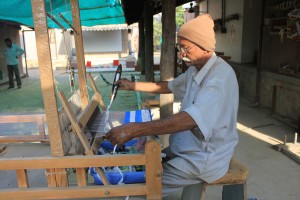 The profits made from the sales go directly to the artisans and their promotion. You can buy a trendy bandhani dress, a woven camel wool shawl, delicate silver jewellery or even the intricately carved wooden artefacts amongst many other indigenous products and be assured of the authenticity of every piece you buy.
The profits made from the sales go directly to the artisans and their promotion. You can buy a trendy bandhani dress, a woven camel wool shawl, delicate silver jewellery or even the intricately carved wooden artefacts amongst many other indigenous products and be assured of the authenticity of every piece you buy.
Mandvi: a city south of Bhuj located on the banks of the river Rukmavati, Mandvi is best known for its pristine beach, the still-active shipbuilding yard and the mesmerizing Vijay Vilas Palace.
 Vijay Vilas Palace: This palace was built in 1929 and is nestled in 450 acres of lush greenery. Still resplendent with its regal charm, it has now been converted into a resort and ensures that anyone who stays here is treated like royalty. Take a break from your routine life and enjoy a majestic sunset (and if you are an early-bird, the sunrise too) from one of the balconies in the palace while watching peacocks and an occasional Chinkara frolic across the palace grounds. A night’s stay here will do wonders to rejuvenate and re-energize you.
Vijay Vilas Palace: This palace was built in 1929 and is nestled in 450 acres of lush greenery. Still resplendent with its regal charm, it has now been converted into a resort and ensures that anyone who stays here is treated like royalty. Take a break from your routine life and enjoy a majestic sunset (and if you are an early-bird, the sunrise too) from one of the balconies in the palace while watching peacocks and an occasional Chinkara frolic across the palace grounds. A night’s stay here will do wonders to rejuvenate and re-energize you.
Kalo Dungar: Kalo Dungar or the Black Hills range is the highest point in Kutch, at 462 metres above sea level. Here one can witness the highlight of the trip: The Great Rann of Kutch!
Great Rann of Kutch: As the name suggests the Great Rann of Kutch, reputed to be the largest salt desert in the world, spans an area of 7505.22 Sq. km. It is an awe-inspiring sight to see the stark white Rann uniting with the horizon at infinity, making you feel like you are truly standing at the edge of the earth. This is one of the places where civilians can get closest to the Pakistan border and even drive up to the India Bridge which is the last point where civilians can reach in this part of India.
Dhordo village: The Dhordo village near Hodka has an ancient water harvesting technique called Virda that everyone must see and learn from. The locals dig shallow wells in low depressions called jheels (tanks) which accumulate and store rain water in such a way that it filters the salty hard water from the potable fresh water. These Virdas are found all over the Banni grasslands, a part of the Great Rann of Kutch.
Rann Utsav: The Rann Utsav festivities takes place each year on a full moon night in December at the village of Dhordo on the Banni Grasslands. Started in 2005 by the Tourism Corporation of Gujarat Limited (TCGL) as a three day affair, the Rann Utsav has grown into a huge affair of three months today. Celebrated each year during December to March, the festival provides an exclusive opportunity to witness the creative initiative of the artisans and craftspeople of Gujarat. Cultural troupes from various districts of Gujarat participate in the Dance and Musical Carnival. The highlight of the event though, is the full moon shining upon the white sands of the Rann and casting a silvery sparkle across its vast expanse. In the evenings, it is a picture perfect sight to see the sunset over the far off flat salt laden Rann and the multihued turbans and lehengas of the local men and women all around you.
Nirona Village: Nirona village is special as it is home to the 300 year old art of Rogan painting. This is a free hand painting style and done without using any prior sketched pattern on the fabric. The painter uses a 6 inch long, thin metal stylus, dipped into the colour and carefully turned to wrap the Rogan around it to paint the fabric. Today, the Rogan art exists only in this part of the world and Khatri Ghafoor Bhai along with his family has kept the art alive by practicing it for generations. Along with the Rogan art, Nirona is also famous for two other rare arts, namely, Copper Bell Making and Lacquer work. Only two villages in India make the Copper bells – Nirona and Zura. It is done by the Lohars of the Muslim community. 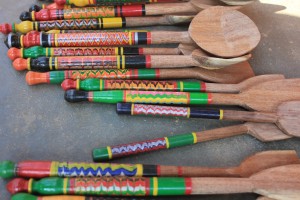 Lacquer work is similarly practiced specially in Kutch and more so in this tiny village of artisans. Lacquer ware is done by colouring hand-carved wooden items with resin obtained from trees. The lac is applied and polished to a smooth glazed finish on a variety of products, from kitchen ladles to little jewellery boxes. It is a humbling experience to watch these talented and renowned artists work while explaining every detail of their art to us with so much passion.
Lacquer work is similarly practiced specially in Kutch and more so in this tiny village of artisans. Lacquer ware is done by colouring hand-carved wooden items with resin obtained from trees. The lac is applied and polished to a smooth glazed finish on a variety of products, from kitchen ladles to little jewellery boxes. It is a humbling experience to watch these talented and renowned artists work while explaining every detail of their art to us with so much passion.
Dinosaur Fossil park: The unusually interesting landscape and topography of Kutch was singled out by British officials in the 19th century as a rich site for finding fossils. Since then, numerous researches and excavations have been conducted here and a variety of fossils have been recovered from the rocks. 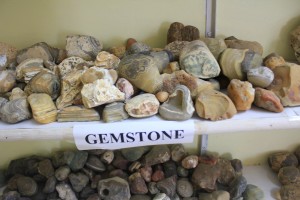 Around 70 km from Bhuj is the ‘Fossil Park’ founded by Mohansinh M. Sodha; a collector who has such a large collection of original fossils that he has set up this museum of sorts all by himself. Mr. Sodha even has a fossil of a vertebrate sea-cow which was found to be a new species itself and eventually named after him as Dommingia Sodhae. Another spectacular fossil on display is that of a Dinosaur (yes, that’s right, I said Dinosaur!), its teeth and even a Dinosaur egg! You can even meet the amazing Dr. Sodha and get a tour of his museum while he explains every little fossil and the story behind its recovery.
Around 70 km from Bhuj is the ‘Fossil Park’ founded by Mohansinh M. Sodha; a collector who has such a large collection of original fossils that he has set up this museum of sorts all by himself. Mr. Sodha even has a fossil of a vertebrate sea-cow which was found to be a new species itself and eventually named after him as Dommingia Sodhae. Another spectacular fossil on display is that of a Dinosaur (yes, that’s right, I said Dinosaur!), its teeth and even a Dinosaur egg! You can even meet the amazing Dr. Sodha and get a tour of his museum while he explains every little fossil and the story behind its recovery.
Than Monastery: At the foothill of the inactive volcanic Mt. Dhinodhar nestles the Than Monastery. Legend has it that it was here, on top of Mount Dhinodar, that the sage Dhoramnath, founder of a tantric order of yogis known as the Kanphatas (‘Split Ears’), is said to have performed a 12-year penance, standing on the crown of his head. He then established the Than Monastery for fellow sadhus. Today, this monastery (more like a temple) is over 400 years old and you still get to see sadhus living here. For the adventure lover, a short trek up the Dhinodhar Mountain will be well rewarded with a stunning view of the Rann of Kutch and one can also see plenty of wildlife on the way up.
Chhari Dhand wetland reserves: Chhari means ‘salt affected’ and Dhandh means ‘shallow wet-lands’. This place is a paradise for bird watchers and ornithologists, with around 370 bird species and being particularly rich in raptors, waders and larks. This place is also famous for the migratory pink flamingos that come here every year in large numbers. The Banni grasslands and the adjoining desert of the marshy salt flats of the Rann of Kutch are also known to host an unexplained phenomenon of dancing lights, locally known as Chir Batti or Ghost lights. Intrepid travellers have plenty of reasons to visit this place and maybe even explain the ‘ghost lights’, if they’re not too spooked.
Mata no Madh: Mata no Madh hosts the famous temple of Ashapura Mata, the head deity of Kutch. This temple is always busy with local people along with tourists thronging to seek the blessings of the deity. After the darshan, head outside to gorge on the famous Kutchi Dabelis and jalebis renowned for their tantalizing effect on your taste buds.
Lakhpat: The erstwhile city of millionaires, Lakhpat is located at the far north-west corner of Kutch. It is known for its historic significance as a major trade city and a port. Today, this place is as good as a ghost town with only vestiges of its former grandeur. Anyone interested in history and a philosophical contemplation on the changing nature of wealth and power will have plenty to think about in this town. A bustling and prosperous port, Lakhpat lost its significance when the Sindhu River changed its course away from this town after great earthquakes in 1819. This also made the Great Rann dry up and form a vast desert land that now stands guard at the border of India and Pakistan. 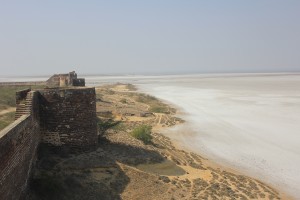 The 7 km long fort walls erected during Lakhpat’s glory days, still stand erect today and offer a magnificent view of the Great Rann of Kutch. A sunset or sunrise at this place is indeed a surreal sight to behold. Lakhpat has a religious significance as well for three of India’s most followed religions-Hinduism, Sikhism and Islam. The Hatkeshwar temple, the Lakhpat Gurudwara Sahib, the Nani Mai Dargah and the Syed Pir Shah Dargah are all located inside the Lakhpat fort walls. All of these religious locations have a remarkable history and an even more breathtaking architecture. Most noteworthy amongst all is the nine-domed mausoleum of Syed Pir Shah which has intricate carvings and excellent stonemasonry.
The 7 km long fort walls erected during Lakhpat’s glory days, still stand erect today and offer a magnificent view of the Great Rann of Kutch. A sunset or sunrise at this place is indeed a surreal sight to behold. Lakhpat has a religious significance as well for three of India’s most followed religions-Hinduism, Sikhism and Islam. The Hatkeshwar temple, the Lakhpat Gurudwara Sahib, the Nani Mai Dargah and the Syed Pir Shah Dargah are all located inside the Lakhpat fort walls. All of these religious locations have a remarkable history and an even more breathtaking architecture. Most noteworthy amongst all is the nine-domed mausoleum of Syed Pir Shah which has intricate carvings and excellent stonemasonry.
 Narayan Sarovar: This lake is one of the 5 holy lakes of Hinduism and is associated with a time of drought in the Puranic area, when Narayan (a form of Lord Vishnu) appeared in response to the fervent prayers of sages and touched the land with his toe, creating the vast oasis like lake in the middle of the deserted Kutch.
Narayan Sarovar: This lake is one of the 5 holy lakes of Hinduism and is associated with a time of drought in the Puranic area, when Narayan (a form of Lord Vishnu) appeared in response to the fervent prayers of sages and touched the land with his toe, creating the vast oasis like lake in the middle of the deserted Kutch.
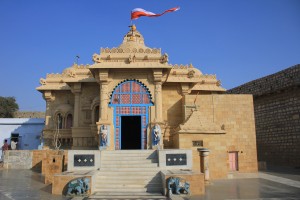 Koteshwar temple: Located right at the edge of the Arabian Sea, this temple is the last outpost of human construction at the westernmost limit of India. Legend has it that if you look closely enough, the lights from Karachi in Pakistan can actually be seen from here at night.
Koteshwar temple: Located right at the edge of the Arabian Sea, this temple is the last outpost of human construction at the westernmost limit of India. Legend has it that if you look closely enough, the lights from Karachi in Pakistan can actually be seen from here at night.
Activities – all the crazy activities that we can organise for you, to add some adventure to your journey
This circuit across the westernmost reaches of the Indian subcontinent takes you across a rich cultural tapestry. Activities include local sightseeing, visits to handicraft centres and sunrise / sunset viewing and temple visits.
Walking tour of Bhuj: The Hamirsar lake perimeter can be an enjoyable way to squeeze in Bhuj sightseeing, as it passes all points of interest, namely, Aaina Mahal, Prag Mahal, the Kutch Museum, the Ramkund Stepwell and the Swaminarayan Temple.
Handicraft centre visits: To explore the arts and crafts of the Kutch peninsula, visits to handicraft centres at Bhujodi, Shrujan, Khamir, Ashapura Crafts Park, Nirona and Zura villages are rare, offbeat delights.
Dance and Musical Carnival: The Rann Utsav between December and March, is a potpourri of activity, from local handicrafts, dance and music, to palatial pleasures. A must-visit for the intrepid traveller.
Accommodation – there is a variety of accommodation available at each stopover, as per your budget, we can suggest the most viable for your journey
Exit points – where would you like your journey to end?
—————————————————————————————————————
Privacy Policy
Footloose Gypsy is committed to maintaining the privacy of personal information that you provide to us when using the Footloose Gypsy website. This Privacy Policy describes how we treat personal information received about you when you visit www.footloosegypsy.in. We may make content or services from other web sites including our co-branded web sites available to you from links located on http://www.footloosegypsy.in. These other web sites are not subject to this Privacy Policy. We recommend that you review the privacy policy at each such web site to determine how that site protects your privacy.
Privacy Policy Promise
While information is the cornerstone of our ability to provide superior service, our most important asset is our clients’ trust. Keeping client information secured, and using it only as our clients would want us to, is a top priority for all of us at Footloose Gypsy. Here then, is our promise to our individual customers:
We will safeguard, according to strict standards of security and confidentiality, any information our customers share with us.
We will limit the collection and use of customer information to the minimum we require to deliver superior service to our customers, which includes advising our customers about our products, services and other opportunities, and to administer our business.
We will permit only authorized employees, who are trained in the proper handling of customer information, to have access to that information. Employees who violate our Privacy Promise will be subject to our normal disciplinary process.
We will not reveal customer information to any external organization unless we have previously informed the customer in disclosures or agreements, or are required by law.
We will always maintain control over the confidentiality of our customer information. We may, however, share customer information with reputable companies when a customer has expressed an interest in their service or product. Please note that this Privacy Policy does not apply to these other company’s use of customer information.
Whenever we hire other organizations to provide support services, we will require them to conform to our privacy standards and to allow us to audit them for compliance.
We will attempt to keep customer files complete, up-to-date, and accurate. We will tell our customers how and where to conveniently access their information (except when we’re prohibited by law) and how to notify us about errors which we will promptly correct.
Information We Collect
General: When you register, and at other times, we may collect personally identifiable information from you that may include your name, address, telephone number, e-mail address, and facts about your computer. We do not, however, knowingly collect personal information from children under the age of thirteen. In addition, if a user is under 18, unless consent is obtained from your parent/guardian, you are not allowed to provide us with personal information.
Web Site Usage Information: We automatically collect IP addresses and Web site usage information from you when you visit our Web site. This information helps us evaluate how our visitors and customers use and navigate our Web site on an aggregate basis, including the number and frequency of visitors and customers to each Web page, and the length of their visits.
How We Use Information Collected
We may use information in the following ways:
For the purposes for which you specifically provided the information.
To send you e-mail notifications about our new or existing products and services, special offers, or to otherwise contact you.
To enhance existing features or develop new features products and services.
To allow us to personalize the content and advertising that you and others see based on personal characteristics or preferences.
We may combine the information that we collect from you on http://www.footloosegypsy.in with information that you provide to us in connection with your use of our other products, services and web site.
We may disclose and use personally identifiable information in special circumstances where it is necessary to enforce our Terms of Use (for example, when necessary to protect our intellectual property rights). We may also disclose or use your personal information when we, in good faith, believe that the law requires us to do so.
Cookies
We employ cookie technology to help visitors and customers move faster through our site. When you sign on to our Web site or take advantage of several key features, we may pass cookies to your computer. A cookie is a string of information that is sent by a Web site and stored on your hard drive or temporarily in your computer’s memory.
Security
The personally identifiable information we collect about you is stored in limited access servers. We will maintain safeguards to protect the security of these servers and your personally identifiable information.
Internet-based Transfers
Given that the Internet is a global environment, using the Internet to collect and process personal data necessarily involves the transmission of data on an international basis. Therefore, by browsing http://www.footloosegypsy.in and communicating electronically with us you acknowledge and agree to our processing of personal data in this way.
Policy Modifications
We may change this Privacy Policy from time to time. We will post any changes here, so be sure to check back periodically. However, please be assured that if the Privacy Policy changes in the future, we will not use the personal information you have submitted to us under this Privacy Policy in a manner that is materially inconsistent with this Privacy Policy, without your prior consent.
Terms & Conditions
Booking Policy
1) Booking must be confirmed with 100 % payment before the trip.
2) To incorporate any changes to the itinerary before or during travel, full payment for the changes must be made.
3) We are sorry to inform you that Footloose Gypsy cannot be held accountable nor will bear the expenses / or loss of expenses therein for any changes / damages caused due to natural calamities, political unrest, erratic weather and personal health problems.
Cancellation Policy
1) Footloose Gypsy’s cancellation policy applies only to the overhead costs and margins incurred.
i) 30 – 45 days prior to departure: 70% refund
ii) 15 days prior to departure: 50 % refund
iii) Less than 15 days / No-show: No refund
2) For all other costs, incurred where private companies have been engaged for travel and accommodation (includes flights, taxis, hotels, resorts, etc), their cancellation policies will apply and refunds will be allocated accordingly. Permits, visas and other legal documentation cannot be reimbursed.
Cancellation should be confirmed by mailing: amishms@lavender-eel-184169.hostingersite.com or by calling Amish Shah at +91-9922939584
